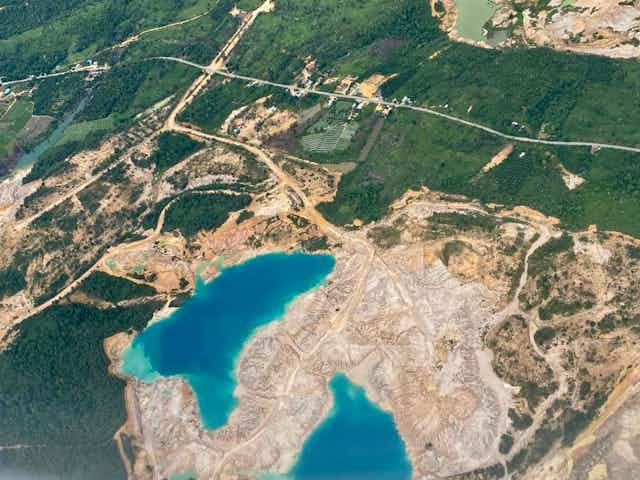Last month, Indonesia’s parliament managed to pass a revised law on mineral resources and coal, the Mining Law No.4/2009, without much scrutiny from civil organisations as the country is practising strict physical distancing.
Like the earlier version, the new revision, Law no. 3/2020, sets no requirements to fill abandoned mine pits.
Our recently published study shows filling mining voids, particularly those close to residential areas, is critical to avoid drownings, especially in children.
To date, rainwater-filled mining pits in the province of East Kalimantan have claimed 37 lives, 32 of which were children under 18.
Unfortunately, the current regulations are insufficient to protect locals from hazardous mining practices.
Lack of legal clarity
Mine reclamation is defined broadly in the previous mining law as an activity carried out throughout the phases of mining to arrange, restore and improve the quality of the environment and ecosystem to enable them to function again according to its designation.
The previous law and the revision require mining license holders to submit a reclamation and post-mining activity plan, and set aside a reclamation and post-mining guarantee in the form of a term deposit.
More specific requirements for reclamation are set out in implementing regulations that state voids must be made safe, slopes stabilised, water quality in voids or on sites restored and monitored, and the mine site re-vegetated.
Other related laws governing mining require setting up fences or warning signs surrounding the mine site.

In our research, respondents said a lack of clarity in previous laws allows mining companies to interpret reclamation narrowly, as limited to re-vegetating cleared land and the overburden (material that has been dug out of the mine pit and piled on site).
Our research draws on key informant interviews, focus group discussions and site observations between December 2018 and May 2019.
Twenty four interviewees were from institutions including national and sub-national government, non-government and community organisations, mining companies and academia.
We also conducted interviews with local mining-affected communities.
We complemented our data with 32 interviews conducted between 2015 and 2017 with key informants from government, international NGOs, development organisations, and mining companies.
We compiled various government data sources, land satellite imagery (2016-2020) and media reports to show the location of mine-related fatalities and mine areas around Samarinda, East Kalimantan.
The law mentioned nothing about refilling the voids back after exploitation, a restoration activity that would be expensive for mining companies. Therefore, normal practice was simply to leave the mining pits behind.

The 2020 Mining Law stipulates five years’ imprisonment and a maximum fine of Rp100 billion (US$6.9 million) if mining business license holders fail to conduct mine reclamation, but the legal meaning of reclamation remains unclear.
The law only states that mining permit holders are required to “manage former mining pits” (Article 99). And, there is still no requirement to fill mining voids.
Prone to drownings
Using government-sourced mining licensing and land cover data, our mapping work shows more drownings occur where mine areas and populated areas overlap.
Smaller pits are more dangerous because they are nearest to roads and housing, however these are less prominent in satellite imagery.
East Kalimantan province, home to the majority of the country’s coal reserves, is scarred with at least 1,735 abandoned mining pits.

As the revised law shifts governance responsibilities, including reclamation, from the provincial to the central government, it could potentially increase the risk of failing to identify small and dangerous pits.
Jakarta-based oversight of mining reclamation practices may have to depend on satellite technology which, unfortunately, might not spot smaller flooded voids.

Our mapping also shows drownings are likely to occur on mining sites classified as “Clean and Clear” (CnC) by government standards.
Holding a CnC certificate means the company has diligently completed the required documents. These documents include recommendations from relevant authorities for their permits and environmental assessments.
However, CnC designation does not assess whether mine reclamation has been performed.
Read more: Afterlife of the mine: lessons in how towns remake challenging sites
What’s next
Money should not be an issue as the 2009 Mining Law required mining companies to submit the reclamation and post-mining plans along with a budget under reclamation guarantee funds.
A deposit is to be made prior to the extraction, and the fund is to be contributed to throughout the period of mining operation until prior to the mine’s closure.
They could use the fund to implement mining reclamation in accordance with their plans. Once companies have proved they have fulfilled their reclamation obligations, they may apply to have their reclamation guarantee returned.
If companies do not conduct reclamation, the government may appoint a third party to conduct reclamation using the stored reclamation funds. This obligation still carries on in the revised mining law.
However, many permit holders fail to comply as it is more economically efficient to just abandon mining pits once coal has been exhausted.
To reduce the chance of more drownings in the future and other adverse social and environmental impacts of mining, it is essential to strengthen regulations for reclamation and to fill mine voids.
The government should also consider increasing opportunities for citizen participation and protecting community rights, instead of loosening regulations for large mining companies.


